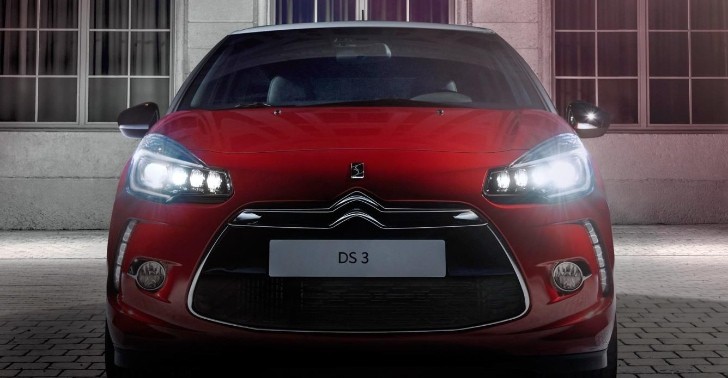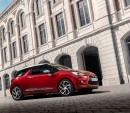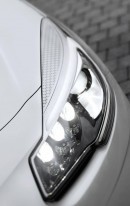Citroen has recently announced the DS range will become an independent brand of premium vehicles with worldwide ambitions. With SUVs and large sedans being recently launched, it's easy to forget the car that started it all: the DS3 premium supermini. Following a teaser released online yesterday, the DS3 facelift has gone official today. With a new beginning, the MINI rival from France comes full circle and is poised to re-become a popular car.
Both the DS3 coupe and DS3 Cabrio will receive a facelift who's main element is a new set of headlights. The outer contour is about the same, which is fine, but the inner bits have changed completely and now combine three individual LED lenses and a xenon unit on each corner.
The larger element is the xenon unit for the low beams, which Citroen says is 35% more energy efficient. The LEDs are smaller and are used exclusively by the high beams, which are 75% more efficient. They also supposedly last 20 times longer with a lifetime of 20,000 hours. Basically, they should be functional as long as the car itself.
Besides the new headlights and other small cosmetic tweaks, Citroen also saw fit to install new engines. The DS3 receives Euro 6-compliant Blue HDi 100 and Blue HDi 120 engines, both 1.6-liter turbodiesels. What they lack in pulling power they more than make up for in the economy department. 100 hp versions can sip as little as 3 l/100km (94 mpg UK) and produce 79 grams of CO2. The more expensive and powerful 120 hp diesel is slightly thirstier at 3.6 l/100km (78 mpg UK) and 94 grams of CO2 emitted.
Perhaps an even more interesting alternative is a petrol 1.2-liter called PureTech e-VTi 82 ETG. At 4.1 liters of fuel consumed (69 mpg UK), this is one of the most efficient petrol engined cars around. However, you do have to put up with an automated-manual five-speed Efficient Tronic Gearbox (ETG).
Our verdict: A bit of nip and tuck can go a really long way. Wow, what a sexy French product!
The larger element is the xenon unit for the low beams, which Citroen says is 35% more energy efficient. The LEDs are smaller and are used exclusively by the high beams, which are 75% more efficient. They also supposedly last 20 times longer with a lifetime of 20,000 hours. Basically, they should be functional as long as the car itself.
Besides the new headlights and other small cosmetic tweaks, Citroen also saw fit to install new engines. The DS3 receives Euro 6-compliant Blue HDi 100 and Blue HDi 120 engines, both 1.6-liter turbodiesels. What they lack in pulling power they more than make up for in the economy department. 100 hp versions can sip as little as 3 l/100km (94 mpg UK) and produce 79 grams of CO2. The more expensive and powerful 120 hp diesel is slightly thirstier at 3.6 l/100km (78 mpg UK) and 94 grams of CO2 emitted.
Perhaps an even more interesting alternative is a petrol 1.2-liter called PureTech e-VTi 82 ETG. At 4.1 liters of fuel consumed (69 mpg UK), this is one of the most efficient petrol engined cars around. However, you do have to put up with an automated-manual five-speed Efficient Tronic Gearbox (ETG).
Our verdict: A bit of nip and tuck can go a really long way. Wow, what a sexy French product!




























